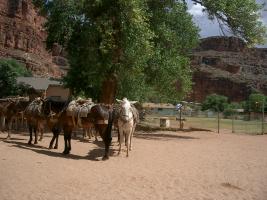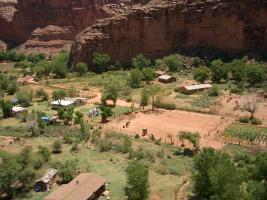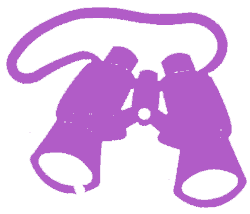
This four-part adventure began with this Blog entry.
There, on horseback at about 2:00 AM on a moonless night, at the foot of the barely visible Havasu Falls, deep in the Cataract Canyon offshoot of the Grand Canyon, accompanied by a medical student and a few laypeople, we came upon a bunch of very sick kids. Two were experiencing bloody diarrhea and were nearly in shock, so we started our only packs of IV fluids with them, while we reassured and tried to comfort the dozen or so others who also had diarrhea.
Of additional concern was the health of the group of younger Boy Scouts, who had left earlier the previous afternoon on an overnight hike to a point several miles downstream, below Moody Falls. We suspected that we were dealing with a waterborne illness. Many of the Scouts had drunk water from the stream and nearby springs, and they had made a fruit punch from the same water. The younger boys had brought the punch with them. Luckily, they made it back later that morning just as they, too, began falling ill.
Communications were difficult. Since we were so deep in the canyon, we had no direct radio contact, and the only phone in the entire canyon was a hand-cranked wire line from Supai Village to Hualapai Hilltop. Messages had to be relayed by a runner between our location and a spot nearer to the village where there was radio reception with the Village. Most of the stricken campers were too ill to be evacuated by horse or mule, and none could walk out. After sunup we moved the sickest patients, and as many others as possible, to the flattened area above the falls, hoping to arrange a helicopter evacuation. However, the characteristics of the canyon as it heats up during the day cause very dangerous air currents. A helicopter from Grand Canyon Village made several unsuccessful attempts to land.
We therefore had the helicopter drop additional supplies, mostly IV fluids to treat and prevent dehydration. In the shade of trees that encircled the clearing on the plateau, we set up a field hospital and readied ourselves for a second night in the canyon.
As a precaution, I asked that the entire western part of the Grand Canyon be closed to visitors. By then the clinical picture suggested that the disease was bacillary dysentery, probably waterborne shigellosis. Some patients started recovering while others developed symptoms. Two were particularly ill and unstable, and we administered antibiotics to them empirically, in the belief that they might not help but neither would they hurt.
Thankfully, the helicopter was able to make several landings the next day, and those who had recovered enough rode out on mules and horses over the next two days. Both of the most serious patients were admitted to Grand Canyon Hospital and they recovered fully. One had a bloodstream infection with the organism, which proved to be Shigella sonnei. Nine out of 26 sick campers examined at the hospital still had the same Shigella organism in their stools.
What had been billed for me as a “VIP Orientation Tour” had turned into a pretty harrowing experience. The canyon stayed closed, and a little over two weeks later I returned with a team of epidemiologists and made a follow-up evaluation of the water and general sanitation. We concluded that the “hippies” from California had contacted the organism by drinking water from a well on their way out to Arizona. They fell ill after arriving, and had contaminated the latrines and even some of the surrounding open area with Shigella sonnei (bacterial dysentery) organisms. A rainstorm that night caused the privies to overflow into the pool under Havasu Falls, and the Scouts who subsequently arrived had simply continued the cycle of contagion by drinking raw creek water and using it to make Kool Aid (which they unwittingly and rather appropriately called “bug juice.”)
The water samples that we obtained from the creek on July 7 gave interesting results. Those from the very beginning of Cataract Creek, where the spring water gushes out from underground, was already quite contaminated by fecal coliform bacteria, with a plate count 108 colonies per 100 milliliter of water. This was probably due to the fact that this “first water” in the otherwise arid southern portion of Supai Canyon attracted many animals to drink there. Plate counts increased enormously, to 720 and more organisms per milliliter as the creek meandered through Supai Village and the many horse corrals and irrigation channels.
At a popular swimming hole just north (downstream) of the Village, the coliform count was even slightly higher, but it decreased to 650, and then to under one per 100 milliter as the creek bubbled over the rocks and meandered through shady watercress beds and over Supai and Navajo Falls on the way down to Havasu Falls. Then, in the pool at the base of Havasu Falls, where the afflicted campers had obtained some of their drinking water, the fecal coliform bacteria increased to 1200 per 100 milliliter, the highest recorded among all the samples. We did not recover the causative Shigella organism, but this is not unusual as they are difficult to isolate as the latrines (presumably the major sourse of the contamination) had been chlorinated and over two weeks had passed since the epidemic That portion of the Grand Canyon remained closed to visitors for over three weeks, a harsh blow for the Indians who depended almost entirely upon tourists for their income.
Return to most recently posted Blog

Before we descended into the depths of the Grand Canyon on that moonless night, my experience riding horses had been limited to pony rides at carnivals. My Government horse Sam was very docile, and I trusted him despite not being able to see anything around us, as we followed the two Indian girls who did not share the reluctance of their elders about guiding us on the trail in utter darkness.
At first the trail was easy, but then we started down a narrow canyon, past Navajo and Supai Falls towards the campground below Havasu Falls. It was unbelievably dark. At one point as we were traversing a narrow ledge along the canyon wall, my horse stumbled a bit. That was scary enough, but he dislodged a rock that tumbled down the cliff and landed, after an ominous delay, with a splash in the river below. Yet I felt that Sam knew the trail better than any of the humans and I felt confident.
Finally we reached level ground, a broad plateau just above the roaring Havasu Falls. Here there was not much of a trail and our horses spread out a bit with me following the lead Indian girl who was slightly to my right. I could see water to my left. The stars reflected in it. It looked like a lake far below us. Sam kept walking toward what I thought was the very edge of a cliff, each step taking him ever closer as my adrenaline started to peak. Then he stepped into eternity, or so I thought. A gentle splash– actually it was just a puddle reflecting the stars!
We descended the steep trail that brought us to the bottom of the falls, and there encountered a chaotic scene. There were kids and young adults puking and groaning all over the place. By now it was about 2:00 AM. Just our presence had a calming effect on the patients, and we quickly obtained and recorded information from each, starting with the sickest. As it turned out, there were three groups of campers, 62 people in all, of whom 26 fell ill. There were 17 Explorer Scouts in this first group, who camped farthest below the falls, then about 30 yards upstream another seven member private group from California (we called them the “hippies”), and 38 younger Boy Scouts whose camp was set up near the base of the falls, but who were nowhere to be seen when we arrived. Eventually, a total of 26 of the 69 people at risk were to fall ill, including two of seven volunteers.
Final Installment of Grand Canyon Adventure: Bug Juice

My tour of duty on the floor of Supai Canyon was scheduled to be brief. Following my descent on a mule to the floor of Supai Canyon, I was to cover a general medical clinic for the physician who normally visited once a week. After an overnight stay, I would simply climb back on the mule and return to Phoenix.
The date was Tuesday, June 24, 1969. Interestingly, there was a half time Forest Ranger assigned to Supai Village, the heart of the Havasupai Reservation on the floor of the western recesses of Grand Canyon. I believe his name was Mr. Greenfield. He was a licensed midwife, so he not only delivered most of the uncomplicated births, but also served as the first line source of all medical care. The clinic was uneventful except that there were many patients, and it continued into the early evening. That night, I really enjoyed climbing into my bunk. The constant thunking of a big generator echoed off the narrow canyon walls, but I paid little attention.
Just before midnight the Forest Ranger aroused me from a sound sleep. A Boy Scout leader had arrived, quite out of breath, to report that a large number of campers had suddenly fallen ill in a campground located about two miles downstream. He said many had vomiting and diarrhea and that some were “bleeding.” He was in the National Guard, so he also asked that we send for a Guard helicopter right away. This was not possible, as the range of our walkie-talkie was very limited, and the land line terminated at the corrals on Hualapai Hilltop, abandoned by that time of night, so we saddled up and set out to the scene of the illness. On a pack horse, we brought along IV (intravenous) setups with fluids, water bottles and a basic first aid kit. By now the nine day old moon had set, and the Arizona stars shone brilliantly.
The Indian who normally would have guided us refused to go during the night, something that made me feel a bit uncomfortable. However, there was a pre-medical student visiting from Loma Linda (John Ward), along with two other college students (Carolyn and Debbie Burkes). They and two teen-aged Indian girls (who agreed to guide us) accompanied Henry and me as we set out in the pitch darkness. I rode Sam, the “Government horse.”
Continues as: Horsemanship in the Pitch Dark
This post is the first of four installments.
Not too many people can say they closed down the Grand Canyon. Well, just a piece of it, but I am getting ahead of myself here. This adventure started in 1969 during my rotation with the Indian Health Service as part of my Tulane University School of Public Health Preventive Medicine residency training. My six week assignment with the Phoenix Area Indian Health Office was to include an orientation visit to Supai Village in the Havasupai Reservation. The reservation is located 2,400 feet below the South Rim of the Grand Canyon. Only about 300 people inhabited the reservation, the most isolated in the United States, accessible only by helicopter or on foot or pack animal down a trail carved out of the sheer canyon walls. It was said to be the only place in the USA where mail was still delivered by mule.
 Henry Keneally, the Health Educator from the Area Office accompanied me. After an overnight stay in a little motel west of Flagstaff, we arose very early to drive about two hours westward on Route 66 past Peach Springs. We then turned to the north on a dirt road for another 66 miles to Hualapai Hilltop (view from Hilltop pictured), our staging area. There was nothing much there except for a corral with horses and mules.
Henry Keneally, the Health Educator from the Area Office accompanied me. After an overnight stay in a little motel west of Flagstaff, we arose very early to drive about two hours westward on Route 66 past Peach Springs. We then turned to the north on a dirt road for another 66 miles to Hualapai Hilltop (view from Hilltop pictured), our staging area. There was nothing much there except for a corral with horses and mules.
An Indian guide greeted us, and as we saddled up I cast an anxious glance at the edge of the canyon that gaped before us. Havasupai means “people of the blue-green water,” but there was no water and nothing green in sight. I learned that the name derived from the color of the water in the stream that passes through Supai Village. The water is high in minerals and is populated by blue-green algae that impart the distinctive color after it is aerated by tumbling over many little falls.
The guide helped me on the mule, the first I had ever ridden. A mule sways as it walks, making you feel like you are riding in a rocking chair. As we approached the edge of the cliff I thought we might be planning to fly down, but the trail suddenly appeared and we moved slowly through switchbacks and one hairpin turn after another. The mule had a disturbing tendency to walk on the very outer edge of the trail, sometimes less than a foot from a 500 foot plunge. I found myself leaning away from the ledge, but the guide cautioned that this only made the mule move farther out. After about a mile of white-knuckle descent, the trail began to level out, and then we entered the head of Cataract Canyon, about six miles from the Village.
![]() Greenery appeared, and as we progressed down the canyon we began to see moisture underfoot. Then we heard the gurgle of water as it erupted from several springs along the way. In no time the creek had become a spectacular rushing torrent. The arroyo widened into Supai Canyon, and eventually we could see the buildings and animals on the flat and green canyon floor. To the sides, the canyon walls were adorned with grotesque statue-like formations, the Wigleeva Rocks (photo). Finally we arrived at the clinic. The physician who usually conducted the regular Tuesday medical visit had the week off, and one of my duties was to cover for him. The next few days turned out to be very eventful.
Greenery appeared, and as we progressed down the canyon we began to see moisture underfoot. Then we heard the gurgle of water as it erupted from several springs along the way. In no time the creek had become a spectacular rushing torrent. The arroyo widened into Supai Canyon, and eventually we could see the buildings and animals on the flat and green canyon floor. To the sides, the canyon walls were adorned with grotesque statue-like formations, the Wigleeva Rocks (photo). Finally we arrived at the clinic. The physician who usually conducted the regular Tuesday medical visit had the week off, and one of my duties was to cover for him. The next few days turned out to be very eventful.
Next Installment: Vacating the Grand Canyon
 As a kid, I often thought how I would like to marry a girl who loved birds. As the hormones raged and the demands of college and medical school intervened, my birding activities dropped off sharply. I had turned into a covert, “underground birder.” My criteria for an eligible wife also changed. Of course, my Mom knew. She almost gave away my secret when Mary Lou and I left on our honeymoon. “Wait until you see what Ken has in his suitcase,” she said. Of course, Mary Lou had no clue and felt quite anxious that it might be chains and a whip! She was most relieved to find binoculars and a bird book!
As a kid, I often thought how I would like to marry a girl who loved birds. As the hormones raged and the demands of college and medical school intervened, my birding activities dropped off sharply. I had turned into a covert, “underground birder.” My criteria for an eligible wife also changed. Of course, my Mom knew. She almost gave away my secret when Mary Lou and I left on our honeymoon. “Wait until you see what Ken has in his suitcase,” she said. Of course, Mary Lou had no clue and felt quite anxious that it might be chains and a whip! She was most relieved to find binoculars and a bird book!
Ironically, Mary Lou was yet to become an avid birder, but only after raising four children. Our youngest child Glen, born in 1967, had severe encephalopathy, a reaction to a measles vaccination at 18 months of age. He lost the ability to walk and talk, and became totally dependent. Mary Lou stayed home and cared for Glen his entire life, until he died at 24 years of age. I retired soon after his death, and we moved into the mountains of New Mexico. Mary Lou’s widowed mother had become increasingly dependent, and she lived with us for several years. Glen died on her 89th birthday (she was born the same day as Bob Hope), and her condition deteriorated. After we moved to New Mexico she finally had to be admitted to a nursing home in Albuquerque, where she died, in 1996 at the age of 94.
During the almost 30 years devoted to the care of our son and her mother, Mary Lou was pretty much homebound. Only one of us would be able to attend family events such as graduations, weddings and funerals. Released from the burden of caregiver, Mary Lou was finally able to travel. We discovered Elderhostel, and so far have attended about 20 programs, many of them birding adventures. Here is link to our Costa Rica/Panama Elderhostel cruise.












